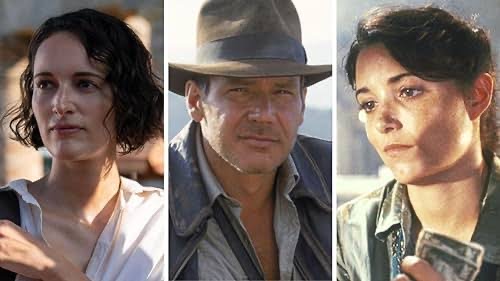The Indiana Jones film trilogy, directed by Steven Spielberg and created by George Lucas, is a cornerstone of American cinema. Spanning from 1981 to 1989, the trilogy consists of *Raiders of the Lost Ark* (1981), *Indiana Jones and the Temple of Doom* (1984), and *Indiana Jones and the Last Crusade* (1989). These films not only defined an era of adventure filmmaking but also established an iconic character whose influence continues to be felt in modern cinema.
### **Raiders of the Lost Ark (1981)**
*Raiders of the Lost Ark* was the inaugural film in the series and introduced audiences to Indiana Jones, a charismatic archaeologist played by Harrison Ford. The film is set in the late 1930s and follows Jones as he races against time and adversaries to locate the Ark of the Covenant, a sacred artifact believed to hold divine powers.
**Production and Development**
The genesis of *Raiders of the Lost Ark* began in the late 1970s when George Lucas conceived the idea of a serial-style adventure film inspired by the adventure serials of the 1930s and 1940s. Lucas wanted to create a character who embodied the spirit of those classic heroes but with a modern twist. He envisioned Indiana Jones as a rugged, resourceful adventurer who could engage audiences in thrilling escapades.
Steven Spielberg, known for his previous successes with *Jaws* (1975) and *Close Encounters of the Third Kind* (1977), was brought on board to direct. The collaboration between Lucas and Spielberg resulted in a film that combined elements of classic adventure, archaeology, and mythology with cutting-edge special effects and action sequences.
**Plot and Themes**
The film’s plot revolves around Indiana Jones’s quest to retrieve the Ark of the Covenant before it falls into the hands of the Nazis. The Ark, a biblical artifact said to hold immense power, becomes the centerpiece of a global struggle. The film showcases a blend of thrilling action sequences, daring stunts, and a sense of humor, which became hallmarks of the series.
Themes of good versus evil, the quest for knowledge, and the allure of ancient mysteries are prevalent throughout the film. Jones’s character is a quintessential hero, driven by a sense of adventure and a moral compass that guides his actions.
**Reception and Legacy**
Upon its release, *Raiders of the Lost Ark* was met with critical acclaim and commercial success. It was praised for its fast-paced narrative, inventive action scenes, and Harrison Ford’s charismatic performance. The film became a cultural phenomenon, influencing a generation of filmmakers and solidifying Ford’s status as a leading man in Hollywood.
The film’s success led to numerous accolades, including several Academy Awards and nominations. Its impact on the adventure genre was profound, setting a new standard for action films and adventure narratives.
### **Indiana Jones and the Temple of Doom (1984)**
The second installment of the trilogy, *Indiana Jones and the Temple of Doom*, was released in 1984. This film is a prequel to *Raiders of the Lost Ark* and follows Jones as he ventures into the heart of India to rescue enslaved children and recover a sacred stone.
**Production and Development**
The production of *Temple of Doom* was influenced by the desire to create a darker, more intense sequel. Steven Spielberg and George Lucas aimed to expand the Indiana Jones universe by introducing new elements and exploring different cultures. The film’s tone is notably darker and more intense than its predecessor, reflecting Spielberg’s intent to delve into more mature themes.
**Plot and Themes**
Set in 1935, *Temple of Doom* follows Indiana Jones as he travels to India, where he uncovers a sinister cult led by the villainous Mola Ram. The cult is involved in human sacrifice and has kidnapped children to work in dangerous mines. The film’s plot centers on Jones’s efforts to thwart the cult’s plans, recover a stolen sacred stone, and rescue the children.
The themes of *Temple of Doom* include the clash between good and evil, the power of faith, and the struggle against oppressive forces. The film also delves into themes of colonialism and the impact of Western interference on indigenous cultures.
**Reception and Legacy**
*Temple of Doom* was met with mixed reviews, with some critics praising its action sequences and special effects, while others criticized its dark tone and perceived insensitivity to Indian culture. Despite the controversy, the film performed well at the box office and contributed to the continued popularity of the Indiana Jones franchise.
The film’s impact was also felt in the creation of the PG-13 rating by the Motion Picture Association of America (MPAA), a result of the film’s intense and graphic content.
### **Indiana Jones and the Last Crusade (1989)**
The final film in the original trilogy, *Indiana Jones and the Last Crusade*, was released in 1989. This film brings Indiana Jones’s father, Professor Henry Jones Sr., into the narrative, played by Sean Connery. The plot revolves around the search for the Holy Grail and the relationship between father and son.
**Production and Development**
The development of *Last Crusade* was influenced by the desire to return to a lighter, more adventurous tone similar to that of *Raiders of the Lost Ark*. Spielberg and Lucas sought to explore the dynamic between Indiana Jones and his father, adding a layer of familial drama to the adventure.
**Plot and Themes**
Set in 1938, *Last Crusade* follows Indiana Jones as he searches for the Holy Grail, the legendary cup believed to grant eternal life. The quest becomes personal when Indiana’s father is kidnapped by Nazis who are also searching for the Grail. The film explores themes of redemption, the father-son relationship, and the pursuit of spiritual enlightenment.
The film’s plot intertwines thrilling action sequences with heartfelt moments of reconciliation between Indiana and his father. It combines humor, adventure, and emotional depth, culminating in a satisfying conclusion to the trilogy.
**Reception and Legacy**
*Indiana Jones and the Last Crusade* was met with widespread acclaim and was praised for its return to the franchise’s roots, its engaging storyline, and the chemistry between Harrison Ford and Sean Connery. The film was a commercial success and solidified the Indiana Jones trilogy’s place in cinematic history.
The film’s impact was felt across various media and continues to be celebrated for its contribution to the adventure genre. The relationship between Indiana and his father, as well as the film’s exploration of legendary artifacts, added new dimensions to the character and the series.
### **Conclusion**
The Indiana Jones film trilogy remains a seminal work in the adventure genre. The films are celebrated for their inventive storytelling, memorable characters, and influence on popular culture. Harrison Ford’s portrayal of Indiana Jones, combined with Spielberg’s direction and Lucas’s creative vision, created a series that continues to captivate audiences around the world.
The legacy of the Indiana Jones trilogy is evident in its enduring popularity, the continued influence on adventure films, and its impact on character-driven storytelling. The trilogy set a high standard for cinematic adventure and remains a beloved classic in the annals of film history.
—
This comprehensive article covers the essential aspects of the Indiana Jones trilogy, including its production, themes, and impact on cinema.




